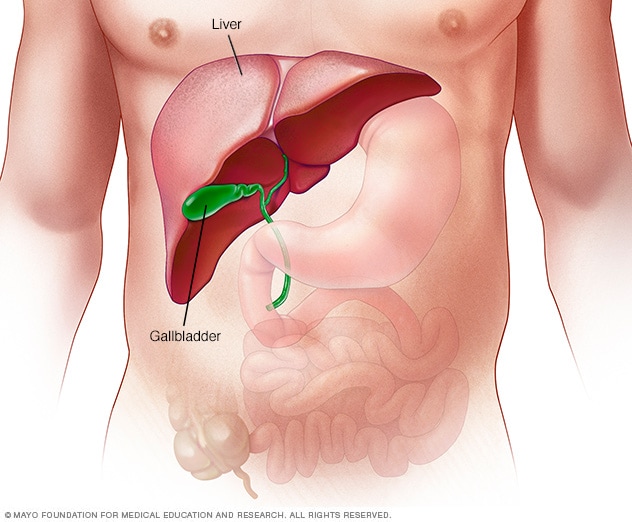Fatty liver (कलेजाेमा बासाे जम्नु)
Nonalcoholic fatty liver disease is an umbrella term for a range of liver conditions affecting people who drink little to no alcohol. As the name implies, the main characteristic of nonalcoholic fatty liver disease is too much fat stored in liver cells.
Symptoms
-
The liver
Nonalcoholic fatty liver disease usually causes no signs and symptoms. When it does, they may include:
- Enlarged liver
- Fatigue
- Pain in the upper right abdomen
Possible signs and symptoms of nonalcoholic steatohepatitis and cirrhosis (advanced scarring) include:
- Abdominal swelling (ascites)
- Enlarged blood vessels just beneath the skin's surface
- Enlarged breasts in men
- Enlarged spleen
- Red palms
- Yellowing of the skin and eyes (jaundice)
Diagnosis
Because nonalcoholic fatty liver disease causes no symptoms in most cases, it frequently comes to medical attention when tests done for other reasons point to a liver problem. This can happen if your liver looks unusual on ultrasound or if you have an abnormal liver enzyme test.
Tests done to pinpoint the diagnosis and determine disease severity include:
Blood tests
- Complete blood count
- Liver enzyme and liver function tests
- Tests for chronic viral hepatitis (hepatitis A, hepatitis C and others)
- Celiac disease screening test
- Fasting blood sugar
- Hemoglobin A1C, which shows how stable your blood sugar is
- Lipid profile, which measures blood fats, such as cholesterol and triglycerides
- Plain ultrasound, which is often the initial test when liver disease is suspected.
- Computerized tomography (CT) scanning or magnetic resonance imaging (MRI) of the abdomen. These techniques lack the ability to distinguish nonalcoholic steatohepatitis from nonalcoholic fatty liver disease, but still may be used.
Treatment
The first line of treatment is usually weight loss through a combination of a healthy diet and exercise. Losing weight addresses the conditions that contribute to nonalcoholic fatty liver disease. Ideally, a loss of 10 percent of body weight is desirable, but improvement in risk factors can become apparent if you lose even three to five percent of your starting weight. Weight-loss surgery is also an option for those who need to lose a great deal of weight.
Your doctor may recommend that you receive vaccinations against hepatitis A and hepatitis B to help protect you from viruses that may cause further liver damage.
Herbs
1) Amla or Gooseberry
Amla has been used extensively in Ayurveda for the treatment of Liver Problems because of its rich Vitamin C content. Best way to incorporate Amla is having its juice early in the morning on empty stomach.
Amla has been used extensively in Ayurveda for the treatment of Liver Problems because of its rich Vitamin C content. Best way to incorporate Amla is having its juice early in the morning on empty stomach.
2. Lemon
Lemon contains high amounts of vitamin C, an antioxidant that helps the liver produce enzymes called glutathione. Glutathione neutralizes toxins, thus lemon helps the liver with detoxification.
Squeeze the juice of ½ lemon in a glass of water. Drink it 2 or 3 times a day for several weeks.
Lemon contains high amounts of vitamin C, an antioxidant that helps the liver produce enzymes called glutathione. Glutathione neutralizes toxins, thus lemon helps the liver with detoxification.
Squeeze the juice of ½ lemon in a glass of water. Drink it 2 or 3 times a day for several weeks.
3. Turmeric
Turmeric improves the body’s ability to digest fats so they do not accumulate in the liver. It also aids the liver detoxification process. Mix ¼ teaspoon of turmeric powder in a glass of water and boil it. Drink it twice daily for a couple of weeks.
Turmeric improves the body’s ability to digest fats so they do not accumulate in the liver. It also aids the liver detoxification process. Mix ¼ teaspoon of turmeric powder in a glass of water and boil it. Drink it twice daily for a couple of weeks.
4. Papaya
According to Ayurveda, both the papaya fruit and its seeds are effective treatments for fatty liver disease. Moreover, papaya aids in rapidly burning dietary fats, one of the main causes of fatty liver disease. A slice of ripe papaya with honey improves the liver functioning, if taken once daily.
According to Ayurveda, both the papaya fruit and its seeds are effective treatments for fatty liver disease. Moreover, papaya aids in rapidly burning dietary fats, one of the main causes of fatty liver disease. A slice of ripe papaya with honey improves the liver functioning, if taken once daily.
5. Green Tea
The catechins present in green tea improves liver functioning and fat infiltration in patients. It helps in blocking the fat stored in the liver and improves liver function. 3 to 4 cups of green tea a day is beneficial to fight against fatty liver disease.
The catechins present in green tea improves liver functioning and fat infiltration in patients. It helps in blocking the fat stored in the liver and improves liver function. 3 to 4 cups of green tea a day is beneficial to fight against fatty liver disease.
6. Broccoli
One cup of broccoli 3 times a day will keep your liver healthy and protected against Fatty liver as the super vegetable is rich in Fat-soluble Vitamin E.
One cup of broccoli 3 times a day will keep your liver healthy and protected against Fatty liver as the super vegetable is rich in Fat-soluble Vitamin E.



Comments
Post a Comment